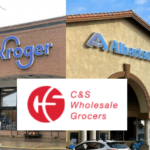
Video screens in the store play ads and provide product information. Digital tags at the shelf light up with product prices. But are these high-tech tools a welcome addition to your neighborhood grocery store, or are they watching you, manipulating you and tricking you into paying more?
A new survey finds most shoppers are okay with this new technology. But at least one lawmaker says they shouldn’t be.
As an “industry leader in technology-driven shelf-edge media solutions,” the company Vestcom has a vested interest in its technology-driven shelf-edge media solutions gaining consumer acceptance. So it conducted a survey to find out what shoppers think about these in-store screens and how retailers can best utilize them.
And its report, “Digitizing the Store with the Consumer in Mind,” found that shoppers have some suspicions, but – happily for Vestcom – most seem receptive to the messages that retailers and marketers are offering.
Two-thirds of shoppers surveyed said they don’t mind electronic price labels and don’t believe they impact the shopping experience. Those who prefer them “appreciate the accurate pricing information and the clean, consistent look on the shelves,” the report states.
But that consistency and uniformity has its drawbacks. “Others prefer paper tags for their ease in identifying sales and promotional offers, locating product prices, and quickly finding what they need on the shelf,” Vestcom found. As the image above shows, a digital price tag can only display so much information. Larger, more colorful paper tags may still be necessary to call attention to sale prices or the availability of coupons. “QR codes continue to increase as a preferred method to access coupons while in store,” the report notes, which electronic shelf labels’ “size/resolution limitations make challenging.”
As for larger in-store digital displays, half of shoppers said video screens have a positive impact on their grocery shopping experience, especially if they provide useful information about sales, promotions and new products.
What about concerns that digital displays can get a little too personal, though, or that digital price tags might be used to overcharge shoppers?
About half of shoppers surveyed said digital price displays that can be adjusted in real time “offer better value.” But, Vestcom acknowledged, “younger generations are more skeptical.” Nearly a third of Gen Z shoppers expressed concerns about “dynamic pricing,” or digitally-displayed prices that can be raised in response to increased demand. Shoppers are also “wary of retailers running digital ads simply as a revenue land grab,” and are concerned about “cameras/sensors incorporated into some digital displays that encroach on my privacy.”
Those are precisely the concerns that some lawmakers have expressed recently. Over the summer, two U.S. Senators wrote to the CEO of Kroger, asking pointedly whether the retailer planned to use its digital price tags for dynamic pricing. And last week, Democratic U.S. Representative Rashida Tlaib went even further, writing to Kroger not only about dynamic pricing, but about digital displays that are watching you while you watch them.
“I understand that Kroger is intending to place cameras at its digital displays, using facial recognition technology to determine the gender and age of customers captured on camera to present targeted advertisements to display,” Tlaib wrote. Digital price tags, together with hidden cameras, she continued, “will allow Kroger to use customer data to build personalized profiles of each customer to determine the maximum price of goods customers are willing to pay.” It’s “concerning,” she concluded, “when we are hearing growing complaints about the rising cost of groceries at big retailers.”
Kroger once tested a facial recognition system several years ago, similar to one that others have tried out, using video analytics to determine a shopper’s gender or age in order to display personalized ads and coupons. But it now says the concept never expanded beyond a pilot program and isn’t in use today. And electronic shelf tags, it said in a statement, are “designed to lower prices for more customers where it matters most. To suggest otherwise is not true,” denying that it is employing, or planning, dynamic pricing.
So with a lot of suspicion still out there, Vestcom says retailers need to proceed cautiously. “They must not lose sight of the impact to the customer,” its report advises, suggesting that retailers “carefully consider proactive communication” about how digital displays and shelf tags can “benefit their customers and provide reassurance around their pricing policies.”
Ultimately, “the role of in-store digital screens could prove vital in the battle for customer loyalty and increased sales,” Vestcom concludes. But the key word there could be “battle” – because it seems that retailers’ high-tech transition won’t come without a fight.
Image source: Vestcom










